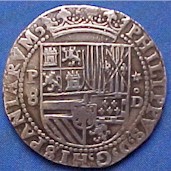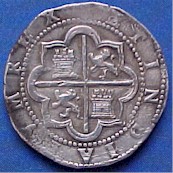|
Atocha Coin Design
The
coin design in use during the Atocha time period, referred to as shield
type, incorporated the Spanish coat of arms or shield on the obverse
side and a cross representing the union of Church and State on the
reverse. The elements of the design between the three major mints,
Mexico City, Lima and Potosi, although similar, have features which make
differentiation possible. This is especially true of the Mexican versus
Peruvian coins. Shield type cob coinage was first struck at the Mexico
City mint in 1572 and ceased production in 1733 when it was replaced by
the machine struck pillar dollar. The Lima mint also struck shield type
coins in 1572, but only a few coins were minted before operations ceased
the same year. The mint reopened for a 12-year period between 1577 to
1588 using the same design. Potosi began striking coins in 1574 using
dies from the Lima mint. Shield type production ceased at Potosi in 1652
when it was replaced by the pillar and waves design. Dated coins first
appeared at the Mexico City mint in 1607 followed ten years later at the
Potosi mint in 1617.
 Shield elements on the obverse
identify lands controlled by the king. Displayed is the Hapsburg Shield
that appears on cobs minted during the reign of the Hapsburg kings
beginning with Philip II (1556-1598) and ending with Charles II
(1665-1700). The shield design changed with the first Bourbon King,
Philip V in 1700. Although not displayed, its primary identification
feature is the prominent three Bourbon fleurs-de-lis arrangement located
at the center of the shield.
Shield elements on the obverse
identify lands controlled by the king. Displayed is the Hapsburg Shield
that appears on cobs minted during the reign of the Hapsburg kings
beginning with Philip II (1556-1598) and ending with Charles II
(1665-1700). The shield design changed with the first Bourbon King,
Philip V in 1700. Although not displayed, its primary identification
feature is the prominent three Bourbon fleurs-de-lis arrangement located
at the center of the shield.
1. Crown.
2. Quadrants of castles
and lions Kingdoms of Castile and Leon.
3. Mintmark: Mexico City M (with a small o above the M),
Lima
or Potosi P, sometimes located to the right of the
shield.
4. Denomination - Usually located to the right of the shield.
5. Horizontal bar Austria.
6. Diagonal lines Old Burgundy.
7. Vertical Lion Flanders. Sometimes switched with 8.
8. Eagle Tyrol. Sometimes switched with 7.
9. Lion Brabant.
10. Fleur-de-lis New Burgundy or France.
11. Pomegranate Granada.
12. Assayer Usually located to the left of the shield, either Roman
numerals or Arabic.
13. X with eagles in the left and right quadrants Naples and Sicily.
14. Vertical Lines Aragon.
 The cross on the reverse
clearly identifies coins struck at the Mexico City mint. The Greek cross
is found on Lima and Potosi coins. It consists of two intersecting lines
in the shape of a large plus sign. The Florenzada
cross, a large plus
sign flared on the ends and topped with spheres, is found exclusively on
Mexico City coins.
The cross on the reverse
clearly identifies coins struck at the Mexico City mint. The Greek cross
is found on Lima and Potosi coins. It consists of two intersecting lines
in the shape of a large plus sign. The Florenzada
cross, a large plus
sign flared on the ends and topped with spheres, is found exclusively on
Mexico City coins.
15. Cross.
16. Lions and Castles Found within the four quadrants of the cross
and
representing the regions of Castile and Leon. Their
positions
are sometimes transposed.
17. Tressure Arcs located at the ends of the cross and quadrants
making up the border.
Legends are the
words placed around the circumference of both sides of the coin. Legends
are usually incomplete or often times totally missing, but when full
read differently on Mexican cobs versus their Peruvian counterparts. The
meaning however, is the same and reads:
Kings name, by the grace of God,
King of Spain and of the Indies.
In the actual legend, the letter V is always
used in place of the letter U. The Kings name is PHILIPPVS or
PHILIPPVS II (1556-1598), PHILIPPVS III (1598-1621), PHILLPPVS IIII
(1621-1665), CAROLVS II (1665-1700), PHILIPPVS V (1700-1746) or
LVDOVICVS (1724) depending on the time period. King is REX, and
is ET, Grace of God is DEI GRATIA or D.G. for short, of Spain
is HISPANIARVM and lastly of the Indies is INDIARVM.
Starting clockwise at the 12 oclock
position, the legends read:
OBVERSE SIDE (undated)
Mexico City: NAME OF KING DEI GRATIA
Lima and Potosi: NAME OF KING D.G. HISPANIARVM
REVERSE SIDE (undated)
Mexico City: HISPANIARVM ET INDIARVM REX
Lima and Potosi: ET INDIARVM REX
Legends change slightly for dated coins.
Mexican coins display the date in the 10 11 oclock position on
the obverse side necessitating a compressed legend. The Peruvian coins
display the date in the same position but on the reverse where there is
ample space for the addition. A new word appears on the Potosi coins,
ANO, which means date.
Legend changes are:
OBVERSE SIDE (dated)
Mexico City: NAME OF KING DEI G. DATE
Lima and Potosi: unchanged
REVERSE SIDE (dated)
Mexico City: unchanged
Lima and Potosi: ET INDIARVM REX ANO DATE
There were no dated Lima shield type cobs.
The assayer mark
guaranteed the coins proper weight and purity. It consisted of the chief
assayers initial or a monogrammed representation of his name. Records of
the assayer names and dates of tenure are important for dating the coin.
Unfortunately, many such records do not exist or are still buried in the
Spanish archives.
ASSAYER MARKS FOR SHIELD TYPE
COINS
MEXICO CITY - MINTMARK = M (small o over the
M)
|
DATE
1572
thru
1607
1607-1608
1608-1609
1610-1617
1618-1634
1634-1665
1666-1677
1677-1705
1705-1723
1724-1728
1729-1730
1730
1730-1733
|
ASSAYER MARK
O
F
F (small o over the F)
F&D (small o over the D)
F
A
F
D
P
G
L
J
D
R
G
F
|
ASSAYER NAME
Name and exact
dates for the period
1577-1607 are
(first dated coin)
Geronimo Bercerra
Martin Lopez
Jose Eustaquio de Leon
Nicolas de Rojas
Felipe Rivas Angulo
|
|
LIMA-
MINTMARK = P |
|
DATE
1572
1577-1588
|
ASSAYER MARK
X
D, D (small o over 2nd D)
|
ASSAYER NAME
Xines Martinez
Deigo de la Torre
|
|
POTOSI
- MINTMARK = P
|
|
DATE
1574-1576?
1574-1579?
1575-1579?
1580?
1581-1586
1586-1589
1589-1593?
1593-1596?
1596-1605?
1605-1613?
1613
1613-1616
1616-1617
1618
1618-1623
1622-1628
1626-1637
1636-1640
1640-1643
1643-1647
1644-1647
1646-1647
1646
1646-1647
1647-1649
1649-1651
1651-1652
|
ASSAYER MARK
R
M, L
B
C, B, X/S, L
B
A
B
R, RL (monogrammed)
B
R (curved leg R)
C
Q
M
PAL (monogrammed)
T
P, P (small o over 2nd P)
T
T/R
F/R
T/R
T
R
V
P
Z
O (dot in center of O)
E
|
ASSAYER NAME
Alonso de Rincon
Exact dates and some
names for the period
1574-1586 is unknown
Juan Ballesteros
Juan Alvarez
Juan Ballesteros
Baltasar Ramos Leceta
Hernando Ballesteros
Baltasar Ramos Leceta
Francisco Calderon de la Barra ?
Agustin de la Quadra
Juan Sanchez Mejia
Pedro Martin de Palencia
Juan Ximenez de Tapia
Pedro Martin de Palencia
Juan Ximenez de Tapia
Pedro Trevino
Pedro Trevino
Pedro Trevino
Juan Ximenez de Tapia
Felipe Ramirez de Arellano
Geronimo Velazquez
Luis de Peralta
Pedro Zambrano
Juan Rodriguez de Roas
Antonio de Ergueta
|
|  Shield elements on the obverse
identify lands controlled by the king. Displayed is the Hapsburg Shield
that appears on cobs minted during the reign of the Hapsburg kings
beginning with Philip II (1556-1598) and ending with Charles II
(1665-1700). The shield design changed with the first Bourbon King,
Philip V in 1700. Although not displayed, its primary identification
feature is the prominent three Bourbon fleurs-de-lis arrangement located
at the center of the shield.
Shield elements on the obverse
identify lands controlled by the king. Displayed is the Hapsburg Shield
that appears on cobs minted during the reign of the Hapsburg kings
beginning with Philip II (1556-1598) and ending with Charles II
(1665-1700). The shield design changed with the first Bourbon King,
Philip V in 1700. Although not displayed, its primary identification
feature is the prominent three Bourbon fleurs-de-lis arrangement located
at the center of the shield. The cross on the reverse
clearly identifies coins struck at the Mexico City mint. The
The cross on the reverse
clearly identifies coins struck at the Mexico City mint. The